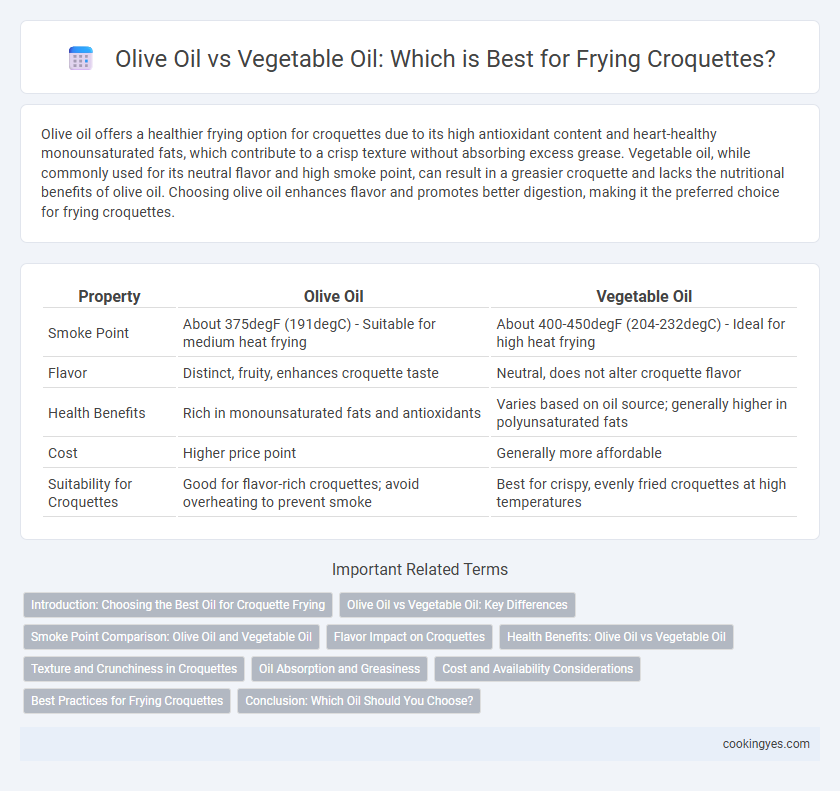Olive oil offers a healthier frying option for croquettes due to its high antioxidant content and heart-healthy monounsaturated fats, which contribute to a crisp texture without absorbing excess grease. Vegetable oil, while commonly used for its neutral flavor and high smoke point, can result in a greasier croquette and lacks the nutritional benefits of olive oil. Choosing olive oil enhances flavor and promotes better digestion, making it the preferred choice for frying croquettes.
Table of Comparison
| Property | Olive Oil | Vegetable Oil |
|---|---|---|
| Smoke Point | About 375degF (191degC) - Suitable for medium heat frying | About 400-450degF (204-232degC) - Ideal for high heat frying |
| Flavor | Distinct, fruity, enhances croquette taste | Neutral, does not alter croquette flavor |
| Health Benefits | Rich in monounsaturated fats and antioxidants | Varies based on oil source; generally higher in polyunsaturated fats |
| Cost | Higher price point | Generally more affordable |
| Suitability for Croquettes | Good for flavor-rich croquettes; avoid overheating to prevent smoke | Best for crispy, evenly fried croquettes at high temperatures |
Introduction: Choosing the Best Oil for Croquette Frying
Olive oil offers a rich flavor and high antioxidant content, enhancing the taste and nutritional value of croquettes. Vegetable oil, with its neutral flavor and higher smoke point, provides consistent frying results and prevents oil breakdown at high temperatures. Selecting the appropriate oil depends on desired flavor profiles and frying temperature control for optimal crispiness in croquettes.
Olive Oil vs Vegetable Oil: Key Differences
Olive oil offers a higher content of monounsaturated fats and antioxidants compared to vegetable oil, enhancing the flavor and nutritional profile of croquettes. Vegetable oil, often a blend of soybean, corn, or sunflower oils, has a higher smoke point suitable for frying at high temperatures but lacks the distinctive taste of olive oil. The choice between olive oil and vegetable oil affects both the texture and health benefits of croquettes, with olive oil imparting a rich, fruity aroma while vegetable oil provides a neutral flavor and crisper exterior.
Smoke Point Comparison: Olive Oil and Vegetable Oil
Olive oil has a smoke point ranging from 375degF to 420degF depending on its type, making extra virgin olive oil less suitable for high-temperature frying like croquettes compared to refined vegetable oil, which typically has a higher smoke point around 400degF to 450degF. Using vegetable oil for frying croquettes ensures better heat stability and reduces the risk of oil breakdown and off-flavors caused by exceeding the smoke point. This makes vegetable oil a preferred choice for achieving crispy, evenly cooked croquettes without compromising taste or safety.
Flavor Impact on Croquettes
Olive oil imparts a rich, fruity flavor that enhances the savory notes of croquettes, creating a more complex taste profile. Vegetable oil offers a neutral flavor, allowing the seasoning and filling of croquettes to stand out without interference. Choosing olive oil boosts the overall flavor depth, while vegetable oil maintains the croquette's original taste.
Health Benefits: Olive Oil vs Vegetable Oil
Olive oil contains a high concentration of monounsaturated fats and antioxidants, which contribute to heart health and reduce inflammation when used for frying croquettes. Vegetable oil, often composed of polyunsaturated fats, can oxidize at high temperatures, potentially forming harmful compounds during frying. Choosing olive oil for croquette frying enhances nutritional value while providing stability and promoting better overall health.
Texture and Crunchiness in Croquettes
Olive oil enhances croquette texture by providing a crispier, golden crust due to its higher smoke point and natural antioxidants, which prevent sogginess. Vegetable oil, often with a neutral flavor and lower saturated fat content, yields a lighter crunch but can result in a less robust crust. For optimal croquette crunchiness and texture, olive oil is preferred, especially extra virgin varieties that maintain high heat stability and enhance flavor complexity.
Oil Absorption and Greasiness
Olive oil typically results in lower oil absorption during croquette frying due to its higher smoke point and antioxidant content, which helps to create a crispier, less greasy crust. In contrast, vegetable oil often leads to higher oil absorption, increasing the greasiness of the croquettes because of its lighter molecular structure and lower viscosity. Choosing olive oil can improve texture and reduce oiliness, enhancing the overall eating experience.
Cost and Availability Considerations
Olive oil generally costs more than vegetable oil, making vegetable oil a more budget-friendly option for frying croquettes, especially in large quantities. Vegetable oil is widely available in supermarkets and grocery stores, while olive oil may be less accessible or more expensive in some regions. For cost-effective frying without compromising availability, vegetable oil tends to be the preferred choice.
Best Practices for Frying Croquettes
Olive oil offers a rich flavor and higher antioxidant content, making it a preferred choice for frying croquettes at moderate temperatures around 350degF (175degC) to preserve its health benefits and avoid smoke. Vegetable oil, with a higher smoke point near 400degF (204degC), is better suited for deep frying croquettes to achieve a crispy exterior without burning the oil. Using oils with stable smoke points and maintaining consistent frying temperatures enhances croquette texture and prevents oil degradation, ensuring best frying practices.
Conclusion: Which Oil Should You Choose?
Olive oil offers a richer flavor and contains beneficial antioxidants, making it ideal for gourmet croquettes that emphasize taste and health. Vegetable oil boasts a higher smoke point and neutral taste, providing a crisp texture without overpowering the croquette's flavor. For balancing health and culinary quality, extra virgin olive oil is recommended for moderate frying, while vegetable oil suits high-temperature, deep-frying needs.
Olive oil vs Vegetable oil for croquette frying Infographic

 cookingyes.com
cookingyes.com